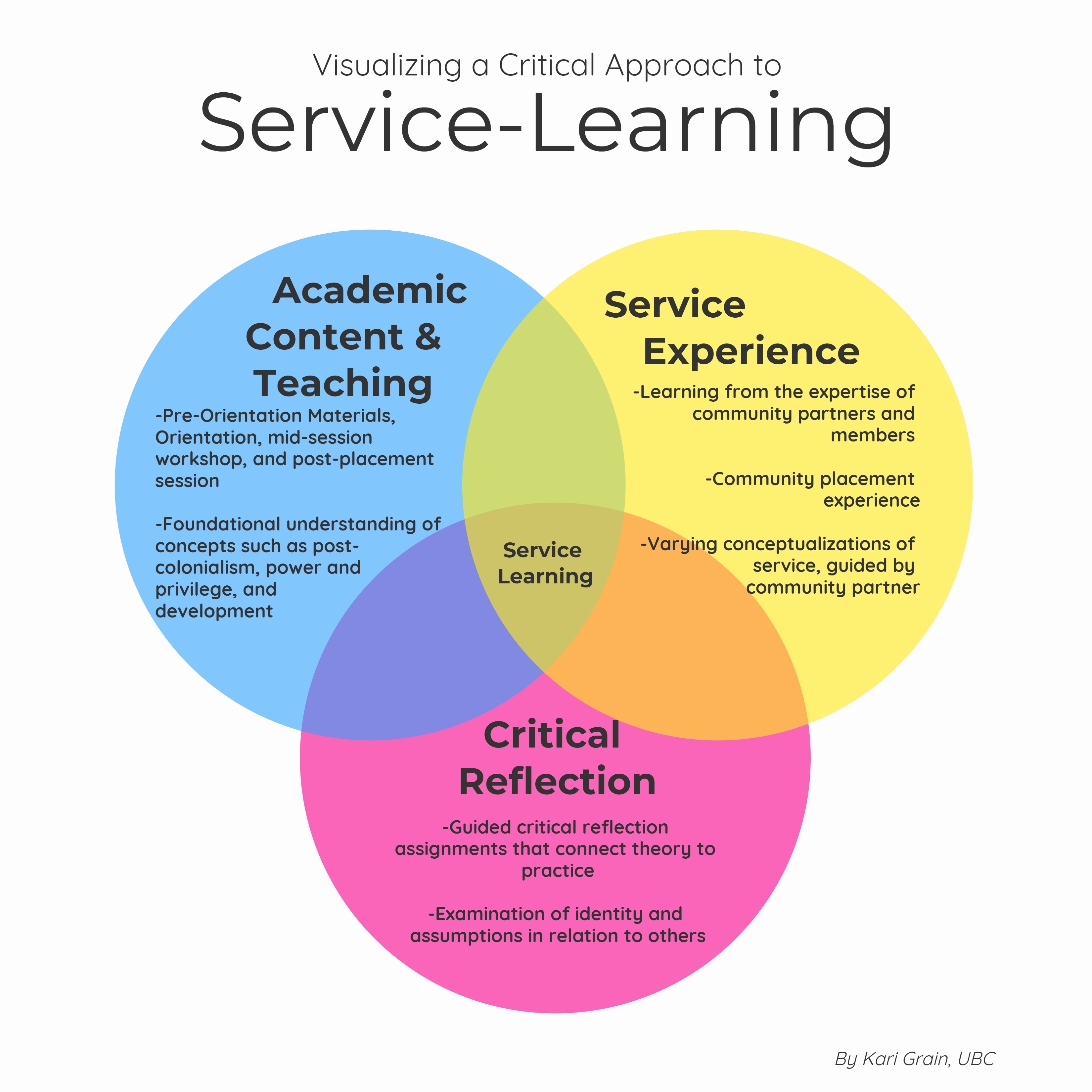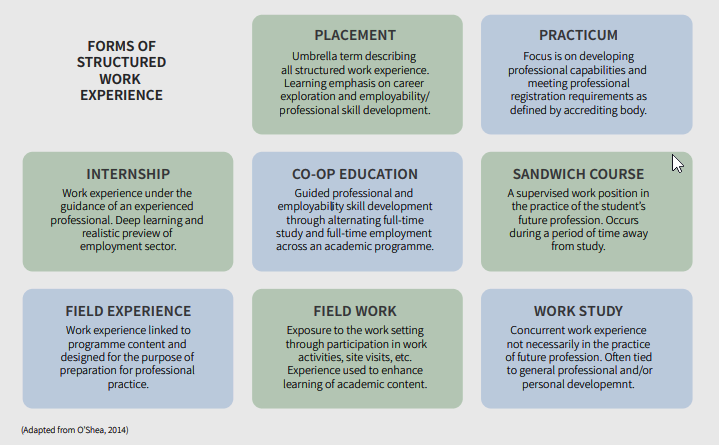“If the theoretical development of experiential education can be summed up in some form of an overarching exploration, it is the on-going quest to define itself”
(Roberts, 2012, p. 3)
Experiential Learning and Education is a field wrought and rich with diverse language, definitions, and debates. This glossary is meant to be a resource for those who wish to understand the differences between various forms of EL. The terms included here are those related to – or under the umbrella of – experiential learning and education. As always, the definitions are contested and in an ongoing state of flux.
*This glossary is being built over time. Please feel free to send me relevant concepts and definitions if you’d like to see them on this page.
Experiential Learning:
“Experiential learning opportunities have a practical or applied experience at their core, are intentionally linked to a learner’s academic degree program, personal development and/or career goals, and integrate reflection. Reflection associated with EL prompts learners to analyze and think critically about their experiences, and express how the experiences help them make sense of their past or create a path for their future” (UBC Okanagan, 2019, Operational Definition)
“Represents the specific techniques or mechanisms that an individual can implement to acquire knowledge or meet learning goals” (Roberts, 2012; HECQO)
“A process of constructing knowledge that involves creative tension among the four learning modes that are responsive to contextual demands. This process is portrayed as an idealized learning cycle or spiral where the learner ‘touches all bases’ –experiencing, reflecting, thinking, and acting — in a recursive process that is responsive to the learning situation and what is being learned” (Kolb, 2005, p. 194)
Experiential Education:
“Refers broadly to a philosophical process that guides the development of structural and functional learning experiences, attends to the ethics of knowledge and outlines the overarching standards for learning environments” (Roberts, 2012)
“A set of intentional experiences and focused reflections that optimize knowledge acquisition, develop life and work skills, clarify values and interests, build meaningful connections, and create opportunities for community engagement on and off campus” (Stanford University, 2018)
“Any form of education that emphasizes personal experience of the learner rather than learning from lectures, books, and other second-hand sources.” (McBrien & Brandt, 1997)
Service-Learning
A form of experiential learning that combines volunteer community service activities, academic content & student learning outcomes , and intentional reflective inquiry involving critical analysis (Kendall, 1990; Saltmarsh, 1997)
International Service-Learning (ISL)
A form of experiential education that integrates community-led service activities, academic instruction, and intentional reflection in an international or cross-cultural setting (Crabtree, 2008)
Global Service-Learning (GSL)
GSL builds on the body of research in international development, international service-learning, and critical theoretical frameworks. What distinguishes GSL from ISL is a foundational moral imperative that embeds the following criteria:
- Students develop an awareness of culture, power, privilege, and hegemonic assumptions;
- Students are immersed in global volunteer spaces; and
- Students engage stakeholders in a critical global civic and moral vision
(Calvert, Peacock, Underwood, Gleeson, okawekiu Kennedy, & Tavcer, 2018; Hartman & Kiely, 2014).
Community Based Learning:
“A set of teaching/learning strategies that enable students to learn by applying knowledge and analytic tools gained in the classroom to pressing issues that affect local communities. Some variations emphasize mutual change on the part of students and community organizations, others, social change, still others, the problem-solving nature of the enterprise.” (Williams College Glossary)
High Impact Practices (HIPs)
High-Impact Practices (HIPs) share several traits: They demand considerable time and effort, facilitate learning outside of the classroom, require meaningful interactions with faculty and students, encourage collaboration with diverse others, and provide frequent and substantive feedback. As a result, participation in these practices can be life-changing (Kuh, 2008; NSSE, 2007)
Work Integrated Learning (WIL)
“A broad term that encompasses various learning opportunities centred on the integration of academic learning and practical application in a chosen work environment” (Sattler, 2011)
(Source: HEQCO Practical Guide for Work Integrated Learning, 2016)
Co-Op (Alternating and Internship Models):
“Co-op alternating consists of alternating academic terms and paid work terms. Co-op internship consists of several co-op work terms back-to-back. In both models, work terms provide experience in a workplace setting related to the student’s field of study. The number of required work terms varies by program; however, the time spent in work terms must be at least 30% of the time spent in academic study for programs over 2 years in length and 25% of time for programs 2 years and shorter in length.” (CEWIL Canada, 2018)
Applied Research Projects:
“Students are engaged in research that occurs primarily in workplaces, includes: consulting projects, design projects, community-based research projects.” (CEWIL Canada, 2018)
Fieldwork:
“In higher education, research carried out away from the institution and in direct contact with the people, natural phenomena, or other entities being studied; especially frequent in fields including anthropology, archaeology, sociology, earth sciences, and environmental studies.” (Hawes & Hawes, 1982)
Internship:
“Short-term, supervised work experience in a student’s field of interest for which the student may earn academic credit. Work can be part-time or full-time, paid or unpaid, on or off campus.” (Hawes & Hawes, 1982)
“Offers usually one discipline specific (typically full-time), supervised, structured, paid or unpaid, for academic credit or practice placement. Internships may occur in the middle of an academic program or after all academic coursework has been completed and prior to graduation. Internships can be of any length but are typically 12 to 16 months long.” (CEWIL Canada, 2018)
Community Engagement (In Higher Education Context):
“Collaboration between institutions of higher education and their larger communities (local, regional, national, global) for the mutually beneficial exchange of knowledge and resources in a context of partnership and reciprocity.” (Carnegie Foundation, 2010)
_____________________________________________________________________
Enriched Educational Experiences (E3s):
Enriched Educational Experiences are characterized by some combination of the following qualities:
A concentrated, immersed engagement with the practice of research and scholarship;
Direct engagement with faculty members, professional practitioners or staff who provide supervision and mentorship;
Active participation of the student, i.e., learning that is to some extent self-directed;
Time-intensive effort, with considerable student time on task;
Experiential activities where students learn by doing, producing, and/or creating, often in contexts beyond the classroom;
Learning in social environments, where students are working with others.
(Sens & Fryer, 2012, Enriched Educational Experiences at UBC: A framework for dialogue and action)
LINKS TO EXTERNAL GLOSSARIES:
- CEWIL Canada: Work Integrated Learning Definitions
- University of Guelph, Community Engaged Scholarship Institute Glossary
- Williams College, Centre for Learning in Action, Experiential Education Glossary
- Adcock et. al (2014) Glossary for Experiential Education in Law Schools

